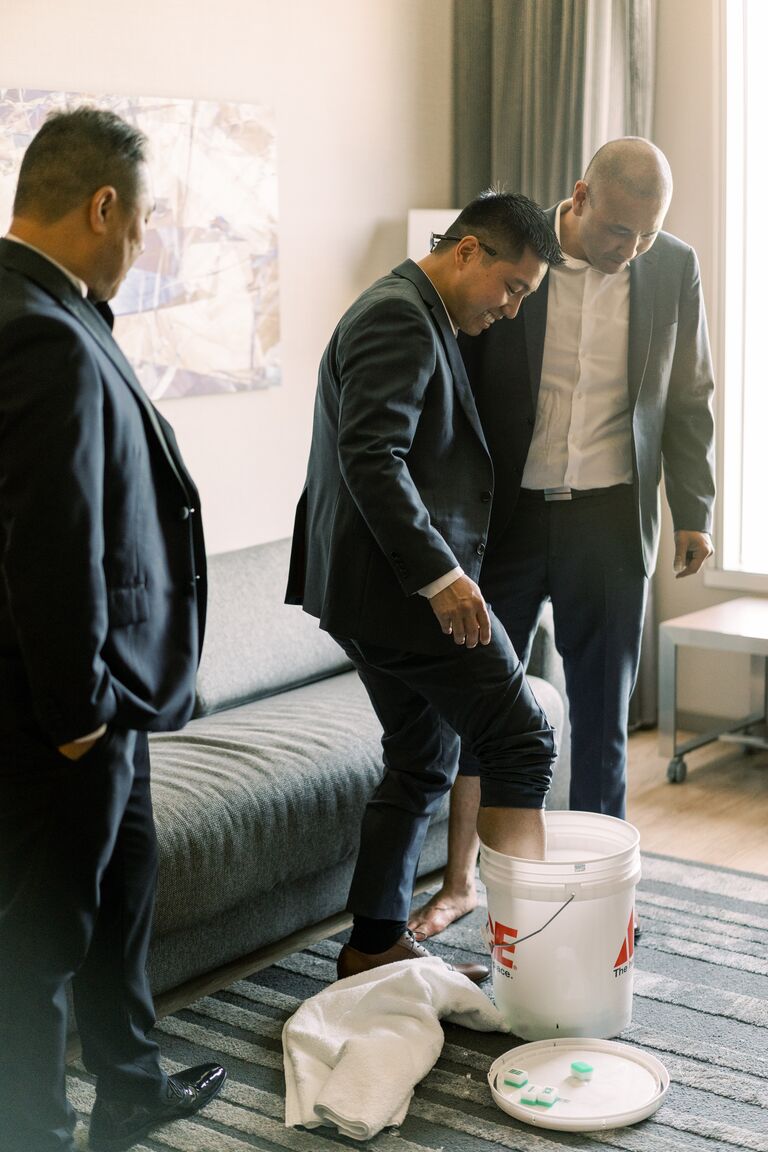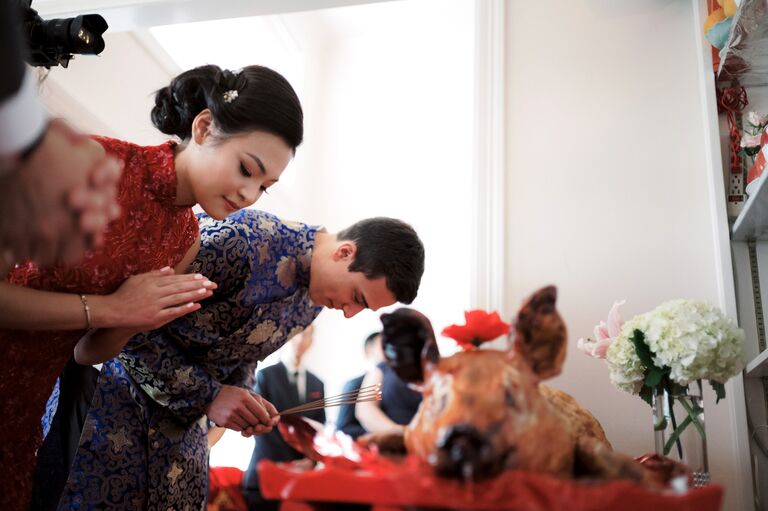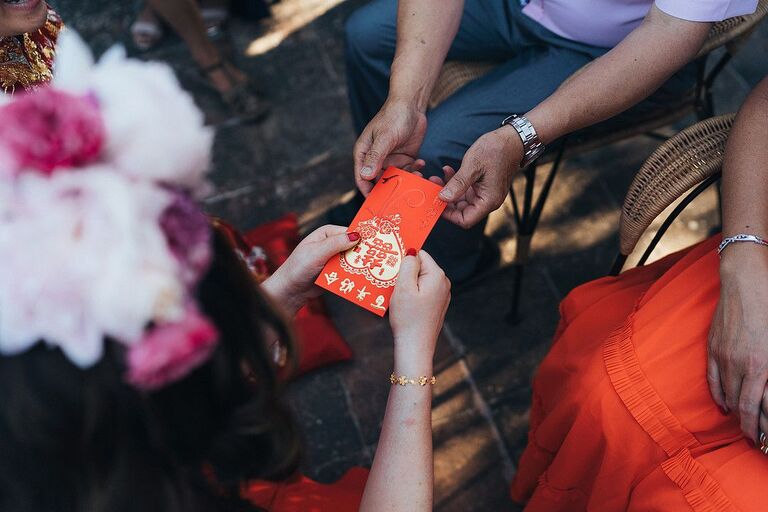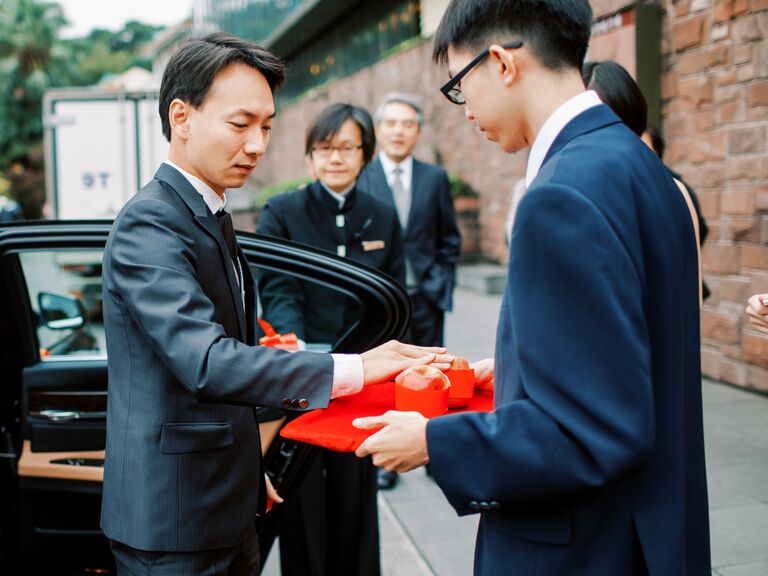15 Traditions Commonly Seen in Chinese Wedding Celebrations
If you're attending a friend's Chinese wedding or you're looking to honor your heritage within your own nuptials, there are a few traditions and rituals typically incorporated into Chinese weddings that you should be aware of. However, it's important to note that "the traditions and rituals of Chinese weddings are as wide and varied as the diversity in the country, which is immense. There are 56 ethnic groups officially recognized by the People's Republic of China," explains Cassie Valente, wedding photographer and owner of Cassie Valente Photography. Furthermore, weddings celebrated by Chinese couples in other Asian countries, like Singapore and Taiwan for example, and in the United States may include elements derived from traditional Chinese weddings while leaving other traditions out of the celebration. To highlight some of the most common Chinese wedding traditions, we connected with Valente as well as other wedding industry professionals for further insight.
While some or all of the below traditions are frequently included in Chinese weddings, a misconception about Chinese weddings is that there isn't space for personalization. Like all weddings, it is your big day to celebrate your way. "I think a possible misconception about Chinese weddings is that with all the history of our culture and plethora of traditions to celebrate, these weddings can't also be extremely, wildly fun! I have tremendous respect for how the Chinese youth of today carry their traditional family customs into the future while bringing in their own sense of style and adaptation," notes Valente.
In This Story:
- 1. Double Happiness Symbol
- 2. Auspicious Colors
- 3. Gate Crashing and Door Games
- 4. Tea Ceremony
- 5. Red Envelopes
- 6. Twelve Gifts
- 7. Gold Jewelry
- 8. Wedding Banquet
- 9. Preparation of the Matrimonial Bed
- 10. Hair Combing
- 11. Historic Post-Wedding Traditions
- 12. Umbrella
- 13. Tossing the Fan
- 14. Firecrackers and Lion Dancers
- 15. Additional Beliefs and Traditions
1. Double Happiness Symbol
Pronounced shuāngxǐ, the double happiness symbol is one of the most recognizable icons incorporated in Chinese weddings. "The Double Happiness character is very aptly named—it's made of two connected copies of the character xi, which means 'happiness.' Hence, Double Happiness! The Double Happiness symbol is very prominent at Chinese weddings and you'll see it on every kind of decoration possible, from wall hangings to cake toppers," explains Valente. The double happiness symbol may also be incorporated into many stationery elements—from the wedding invitations to the red envelopes seen on the wedding day.
2. Auspicious Colors
Red and gold are the two colors most frequently used in color palettes for Chinese weddings. "Across all of Chinese tradition, red is by far and large the most popular color at all major celebrations, including weddings," explains Valente. "The color red is associated with many positive traits such as success, loyalty, honor, fertility and love. Because of this, traditional Chinese bridal dresses are generally red. Gold is also commonly seen in decorative wedding accents, as it portrays wealth and fortune." Fu adds that another characteristic of the color red is that it "is also known to divert negative energy away."
Although red will likely be the prominent color on the wedding day, guests should not wear the hue as it is reserved for the couple of honor as the bride generally dons a red dress. This red wedding dress is known as qipao in Mandarin and cheongsam in Cantonese. "Do not wear black or white to Chinese weddings. Black and white are worn at funerals, so that is considered bad luck. Also, don't wear red, because that's what the bride will wear. Try to wear purples, pinks or warm tones," advises Jenny Fu, wedding photographer and owner of Jenny Fu Photography.
3. Gate Crashing and Door Games
"The beginning of the wedding ceremony often begins first with collecting the bride. The groom and his groomsmen will travel to the bride's house, where sometimes a tea ceremony is performed in order to pay homage to the bride's family, before everyone heads over to the groom's family's house for their own tea ceremony," explains Valente. Fu further elaborates, explaining that "the door games tradition originated from the idea that a bride is a prized daughter, worth so much that her family refuses to marry her off easily. Therefore, a man worthy of her hand must pass specific 'tests' to claim his bride-to-be."
"A really fun Chinese wedding tradition is called heng dai games, gate crashing or door games," concurs Stephanie Bishop, wedding photographer and owner of Starling and Sage. "Not every family does this. But this is when the groom and his groomsmen arrive at the bride's house and they will have to go through challenges set by the bridesmaids before entering the house to see his bride for the first time for the day. Most weddings are all day affairs. From eating crazy foods to doing silly dances, it's up to the bridesmaids' imaginations! My bridesmaids had a blast because I was the very first one to get married in my friend group."
"During these modern 'door games,' sometimes called chuangmen, the groom and his friends may find themselves tasked to complete challenging requests in order to reach the bride, ranging from the 'simple' (perhaps quickly composing and singing an original love song to the bride) to the more complicated—such as doing a certain number of pushups or eating a strange condiment concoction prepared by a mischievous bridesmaid," says Valente. "A more creative challenge I witnessed once was having the groomsmen collect matching pairs of mahjong tiles from a bucket of ice water...using only their bare feet."
The tradition originated in ancient Chinese culture where it was customary for firecrackers, loud gongs and drums to mark the start of the procession (and fend off evil spirits) from the groom's home to the bride's home. The groom would lead a procession, accompanied by a child (to symbolize future sons). Attendants with lanterns, as well as banners, musicians, and a dancing lion would follow. When the groom arrived at the bride's house, the groom's party would be met by the bride's friends, who would haggle with the groom or his representatives. They would make him perform stunts or tricks, and not "surrender" their friend until they were satisfied with red packets of money. As the couple made their way back to the groom's house, firecrackers would be set off just before the procession arrived. A red mat would be placed before the sedan chair for the bride so that her feet wouldn't have to touch the bare earth. The entire household would be waiting to receive her. The bride would be required to step over a saddle or a lit stove to cross the threshold—the fire was thought to cast out evil influences. Although the gate crashing and door games have changed somewhat in modern times, many of the ancient influences still inform this pre-wedding ritual.
4. Tea Ceremony
"The tea ceremony is one of the biggest components in a traditional Chinese wedding," explains Bishop. "Once this is done, it is a sign of marriage in the eyes of Chinese tradition. It's a ceremony where tea is served to the elders of the couple and a chance for the elders to impart well wishes and advice to the soon-to-be newlyweds." Fu goes on to share that during the tea ceremony, "the newly married couple honor their parents by serving them tea. They kneel and serve the parents and in-laws tea. Not only do you serve the parents tea, but you must also serve tea to all of your elders in the family."
"The tea ceremony is my absolute favorite tradition when it comes to honoring parents and grandparents at Chinese weddings, says Valente. "I'm personally so glad to have done a tea ceremony at my own wedding, even though we opted for a very small celebration with just ten guests in attendance. Although the exact details vary from celebration to celebration, most tea ceremonies involve the wedding couple serving tea to their parents and other extended family members as a sign of respect. The tea is sometimes paired with traditional ingredients such as lotus seeds and red dates, a combination that symbolizes sweetness in the marriage and future heirs. At my own wedding's tea ceremony, we took the time to thank our family members in groups of twos, starting with my mother and father, and served them tea while thanking them for raising me and providing me with constant guidance through life. It is an intensely emotional ceremony. "
During ancient Chinese wedding ceremonies, the bride and groom would stand at the family altar, where they would pay homage to heaven and earth, the family ancestors, and the kitchen god, Tsao-Chün. Tea, usually with two lotus seeds or two red dates in each cup, would be offered to the groom's parents. Finally, the bride and groom would bow to each other—completing the ceremony. Either following the wedding ceremony or sometimes the next day, the newlyweds would serve tea to the groom's family. The couple would serve tea in order, starting with the groom's parents then proceeding from the oldest family member to the youngest. After the tea was offered and a sip was taken, the couple would receive lucky red envelopes, lai see, filled with money or jewelry. This was considered the formal introduction of the families.



5. Red Envelopes
While wedding registries filled with everything from stand mixers to honeymoon funds are common within Western-style weddings, this is typically not the case with most Chinese weddings. Instead, red envelopes, known as hong bao, are typically gifted to couples during their wedding ceremonies. "Unlike Western weddings, where there's often a gift registry where you can buy the couple specific household items ahead of time, it's more traditional at Chinese weddings to gift the couple straight cash or gold jewelry," says Valente. "This is why you'll see a lot of parents and extended family members give the wedding couple red envelopes and bridal jewelry during the tea ceremony.
"Red envelopes (also known as hong bao in Mandarin and lai see in Cantonese) are one of the most popular symbols in traditional Chinese culture," explains Valente. "We give these envelopes to wish good fortune and wealth to others, which is why they are so commonly seen during Lunar New Year festivities and at weddings. These small red packets are filled with lucky money and gifted by the older, typically married family members to the younger generation. It totally makes sense to start off a new year or new journey in life with a handful of hong bao!"
In addition to exchanging red envelopes, Allen Tsai, wedding photographer and owner of Allen Tsai Photography, explains that oranges are also sometimes touched during this part of the wedding ceremony. "Oranges are wrapped with red paper and placed on a red plate. Touching the oranges and gifting a red envelope in exchange is supposed to bring good luck and prosperity to the couple. Oranges are more seasonal so often times they are replaced with apples. In Chinese, apples sound like safety and comfort so it's a very welcomed substitute."
6. Twelve Gifts
Although red envelopes are the main gifts exchanged during Chinese weddings, Tsai explains that traditionally the groom's family also had to prepare 12 gifts. "Traditionally, the groom's side has to prepare 12 gifts for the bride's side on the wedding day. Modern weddings have simplified this and usually just do the essential 6 gifts which include wedding cookies, traditional Chinese cake, candles and firecrackers, money and gold jewelry, head-to-toe apparel (clothing, purses, and shoes, and everything has to have a red envelope in it).
7. Gold Jewelry
This is part of the overall exchange of gifts during the wedding, but it's worth noting that gold jewelry is one of the frequent gifts presented during Chinese wedding ceremonies. Valente shares that one of her "favorite funny bridal jewelry gifts to see at Chinese weddings is the infamous gold pig necklace. There's no other way to describe this necklace—it's outrageous. Along with other traditionally gifted jewelry pieces, such as gold dragon and phoenix bangles, these pig necklaces represent a very specific set of well wishes from the guests to the wedding couple. Pigs are quite favored animals in Chinese culture and are associated with happy, lucky and prosperous ideals. So as you can imagine, gifting a bride a 24-karat gold pig necklace with lots of dangling gold baby pigs means you're wishing her a wealthy and abundant marriage, preferably one with many children, as ensuring the longevity of one's family lineage has always been a huge part of Chinese culture." Bishop explains that at her own wedding, she "personally received a diamond bracelet and my husband a gold bracelet from an elder on our wedding day during the tea ceremony."
8. Wedding Banquet
While good food is a staple of most wedding receptions, this is especially true of Chinese wedding receptions, which are all about feasting. "The dinners at Chinese wedding banquets are usually 10-course meals and very lavish," says Bishop. The menus typically include abalone because it is "a sign of good luck and prosperity and status." Fish is also commonly served.
In addition to serving a big feast, the wedding banquet also generally includes a few other elements. "Speeches are typically given during the banquet in which the parents and grandparents are honored. How this is done is specific to each couple. Sometimes there's songs sung also, or a slideshow played. Parents and grandparents are always served dinner first," notes Bishop.
Rice balls are also often consumed during the wedding day. "Eating rice balls signifies that the families will be together and live happily ever after," says Tsai.
In ancient Chinese culture, both the bride's parents and the groom's parents would often host separate wedding feasts. There might be a single feast for each family, or a series of feasts over several days. The most important feast was considered to be the one given by the groom's family on the day of the wedding. This banquet was seen as a public recognition of the union. Historically, the more lavish the display and the more food and leftovers, the more wealthy the hosts. Most of the foods commonly served were symbolic—a whole fish would be served because the word for fish, yu, sounds like the word for plenty, meaning a wish for abundance. Serving sweet lotus seeds for dessert symbolized a wish for many children.
9. Preparation of the Matrimonial Bed
The tradition of Au Chuang is seen less frequently in modern Chinese weddings, but historically the preparation of the matrimonial bed or bridal bed was a Chinese wedding custom that was given special attention. "The room that the couple shares is usually decorated with red and gold (sometimes red lamps) to put the spark into the bedroom and marriage to be easy for them to conceive a child. Traditionally the lamps and decorations are left on for a minimum of three days," says Fu.
The tradition originated with ancient Chinese weddings where immediately following the ceremony, the couple was led to the bridal chamber, where both would sit on the bed. In some areas of China, honey and wine were poured into two goblets linked by a red thread. The bride and groom would take a few sips, then exchange cups and drink the rest.
10. Hair Combing
"The mother of the bride brushes the bride's hair on the morning of the wedding," says Fu. "The mother of the groom also brushes the groom's hair before the ceremony. This ensures they look their absolute best before getting married." Bishop notes that the "hair combing ceremony is one of the more traditional ceremonies that isn't always done with younger and more modern couples. It really depends on how traditional the families are. I personally did not have this done but from other experiences I have heard of, blessings are recited while the respective bride and groom (who are apart, in different houses) have their hair combed at the same time."
11. Historic Post-Wedding Traditions
Historically, the day after the wedding, Chinese brides would wake up early to honor her ancestors at dawn. It was then that she would also be formally introduced to all of the groom's relatives and friends. As she knelt before each of the older relatives, she would receive a small gift. The groom's parents would then give her a title, according to her new husband's seniority in the family. Then, three days after the wedding, the new couple would pay a visit to the bride's family at home. At this time, the bride would no longer be considered a part of her family, but rather a guest in her parents' house.
12. Umbrella
"There's a Chinese superstition that states if a bride walks under a red umbrella whenever she is outside, this will ensure future fertility in the marriage. It's not uncommon to see a bridesmaid assigned to the task of holding the umbrella for the bride," says Valente.
Tsai explains that sometimes a rice sieve is used in place of an umbrella. "The bride is the most significant person on the wedding day, however, to avoid fighting for significance with the gods, a rice sieve is used to block the bride when leaving her home and entering the groom's home."
13. Tossing the Fan
According to Tsai, "tossing the fan before heading to the groom's house signifies that the bride is getting rid of her past stubbornness and bad tempers as a girl and is transforming into a woman in hopes to become a good wife."
14. Firecrackers and Lion Dancers
Many modern couples will have lion dancers perform during their wedding reception as they are said to help ensure the couple has a long and happy marriage by fending off evil spirits. Firecrackers are also often lit as they are "used to scare away all evil spirits," explains Tsai.
15. Additional Beliefs and Traditions
Beyond the traditions noted above, there are a few other customs it is important to keep in mind with Chinese weddings. Firstly, "the number four is considered unlucky, so avoid giving anything in sets of four as a wedding gift," says Fu. Fu also notes that it is "considered rude, so don't leave the wedding without saying goodbye to the bride and groom!"
References:
- Chinese Historical and Cultural Project (CHCP.org)
- Wild Geese and Tea, An Asian-American Wedding Planner by Shu Shu Costa (Riverhead Books, 1997)
- Information about the elements of ancient Chinese wedding ceremonies is generally credited to scholars of the Warring States period (402-221 B.C.).












































